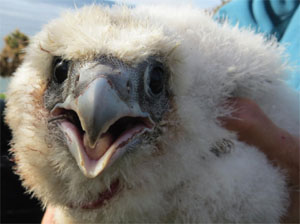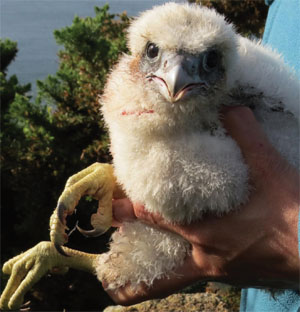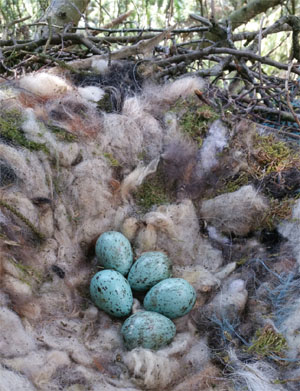|
April / 2018 - Michael Ryan
|
| In
February Ann Fitzpatrick, wildlife ranger with the National Parks and
Wildlife Service who is based in Glendalough, gave a fascinating talk
to a BirdWatch Ireland meeting about the research being conducted on
peregrine falcons in Ireland and specifically her work, colour ringing
peregrine chicks. Traditional ringing of birds is with a small metal band which is placed on chicks in nests or birds caught in mist nets. These rings have a reference number specifically assigned to that individual but any information subsequently obtained about that bird depends on the ring being read after the bird has been trapped or its corpse being found whereas colour bands on birds can be identified from a distance through binoculars, telescope or camera. Ann and her volunteer companions’ survey dozens of peregrine nests in Wicklow and Wexford ringing chicks on their nests, often climbing to the nests in very precarious locations in quarries, cliffs, old towers or ruins. Some peregrines actually nest in working quarries oblivious to the noise, men and machinery nearby although Ann observed if anyone came into the quarry after normal working had stopped when the area would normally be deserted, the peregrines would be much more hostile and apprehensive to their presence. Recently they have been positioning automatic recording cameras near nest sites which provide reams of information and some wonderful photographs such as one of a female peregrine bringing in a bat to feed her solitary chick, apparently one of many bats that bird had developed a strategy of catching at dusk. |
|
|
Photo courtesy Ann Fitzpatrick, NPWS |
|
One
of the peregrines they monitor regularly hatches five chicks which is
almost unprecedented. Incidentally the female peregrine which died of
natural causes while nesting in Dalkey Quarry in 2016, was one of the
biggest and heaviest individuals they’d came across, weighing 1.2kg
- what Ann described as ‘a super bird’. Although doing well in general with a substantially increased population after a near fatal decline during the middle of the last century, peregrines are still subject to illegal persecution by shooting and poisoning. It was Ann who climbed down and ringed the peregrines in Dalkey Quarry in 2014 before somebody tried to kill them by lowering down two racing pigeons covered in poison. They all survived that time but three of those four chicks that fledged that year are now known to be dead, a very sad statistic but a fact that only became known since their origins could be traced back by the rings. Peregrines make very rudimentary nests scraping out earth or gravel to lay their eggs on without collecting any nesting material but they will sometimes occupy raven’s nests. Ravens nests are very elaborate, substantial structures. According to Ann ‘they are just so beautiful - lined with deer hair/wool/horse hair...unfortunately a lot of bailing twine also’ and she said ‘you could climb in to one to have a snooze’. Because of their similar preferences for nest sites they often become very inharmonious neighbours. There’s a fascinating book about ravens recently published, A Shadow Above by Joe Shute which documents the ravens history in Britain, once being held in high esteem and having great significance in folklore and ancient religious beliefs. Ancient tombs have been found to contain bodies of ravens buried with people of high standing, the ravens thought to be seen as guides in the afterlife. Later though for a number of reasons the ravens were mercilessly persecuted and disappeared from much of their range but, like peregrines, are now returning in promising numbers which the writer documents, the book’s sub title being The Fall and Rise of the Raven. Shute isn’t a naturalist or scientist but a journalist, formerly a crime reporter in Yorkshire, with an obvious high regard for these birds and as well as searching out individual raven’s nest sites he meets many people who share his affection for them. Many people who have kept tame ravens don’t consider them as pets but, in testament to their obvious intelligence, individual personalities and their ability to mimic human speech regard them as companions and their affection for them is frequently touching. There’s lots of amusing anecdotes about them as well such as the chap who had a bird rescue centre which included a number of ravens kept in individual aviaries. One raven stole the bunch of keys for the bird’s cages and managed to take all the individual keys off the chain and hide them. The centre manager had to saw through all the locks to remove them while the raven would return a single key every subsequent day. Ravens are members of the crow family but are accorded the honorary status of being included in species studied by the Irish Raptor Group and Ann Fitzpatrick rings many of their chicks as well. |
DALKEY
HOME PAGE | DALKEY
COMMUNITY COUNCIL | DALKEY
HERITAGE COMPANY | CANNONAID





